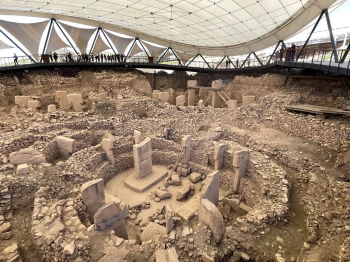In a remarkable find that redefines our image of ancient Roman excess, archaeologists have excavated a 1,600-year-old Roman villa in the city of Tripolis in Denizli province, western Türkiye. Replete with elaborate frescoes, fountains, and an intricate network of fish ponds, the newly excavated villa offers a fascinating insight into the refined lives of Anatolia's Roman elite.
A Villa That Whispers of Grandeur
Spreading over a total area of approximately 1,500 square meters, the villa is among the most important buildings in terms of architecture ever excavated in Tripolis. Pamukkale University Head of excavation Professor Bahadır Duman stated that it was larger and more ornamented than the typical houses of the era.
This villa is one of a kind in terms of size and architectural detail,"Duman said. "The interior is full of color — yellows and blues, reds and browns — every square inch frescoed and covered in botanical motifs.".
The villa contains four rooms, two great halls, an underground cistern, two fountains, and a 20-meter-long colonnaded gallery. Its true piècede résistance, however, lies within its courtyard: a 40-square-meter decorative fish pond, quite sophisticated in design and symbolism.
A Fish Pond Fit for Emperors
It is not mere decoration, the pond illustrates Roman engineering ingenuity along with cultural appetite for the theatrical. Baked clay pipes inserted into its walls created fish hiding places — a trick that also protected them from predators and the sun's heat.
Carp, catfish, and eels would have been raised here and served atbanquets, Duman said. "Fish ponds in Roman times weren't just aboutfood," he said. "They were status symbols. Hosting guests near one was a mark of sophisticated taste and high social standing."
The find is all the more remarkable given that Tripolis is situated far inland. That an aquatic building of such excellent state of preservationshould be found so far inland is a testament to the wealth and aspiration of its owners.
Tripolis: Western Anatolia's Hidden Treasure
Located along the Büyük Menderes River, Tripolis has been a treasure trove for an archaeologist in the past decade. The pièce de résistance in earlier excavations was a 1,500-year-old church, a 2,000-year-old villa containing 12 mosaic-adorned rooms, Roman-era marketplaces, and even a centuries-old board game resembling early backgammon.
The current dig falls under the Turkish Ministry of Culture and Tourism's Heritage for the Future project. The restoration work, whichis being conducted by 40 researchers and archaeologists, aims to preserve and eventually open parts of the site to the public.
Why This Discovery Matters
The villa's synthesis of aesthetic and practical luxury has a wider story to impart — not simply of Roman everyday life, but of the way that Anatolia was situated at the very center of the empire's cultural and economic existence. It also illustrates that luxury in the ancient world was not confined to coastal settlements or imperial capitals.
SUCH architectural complexity and decoration so far inland is incredible," Duman emphasized. "This villa offers a rare insight into how the Roman elite lived, entertained, and expressed their status in Anatolia."
Final Thoughts
As digging persists, every layer uncovered from the ground draws us nearer to a civilization that still echoes today in its love of art, nature, and design. This villa — with fresco-adorned walls, running water, and sparkling fish — is not just a wonder of archaeology but a lyrical cuethat luxury, in essence, is ageless.






